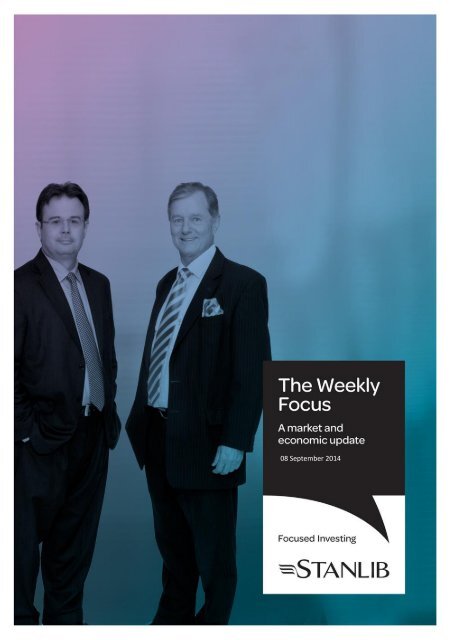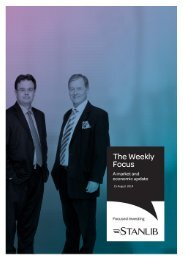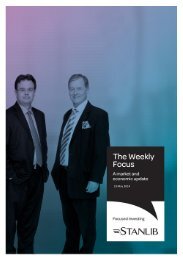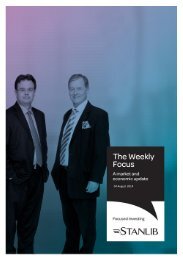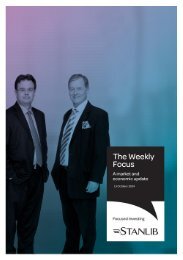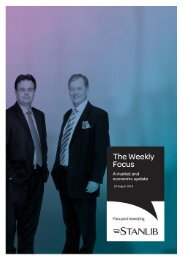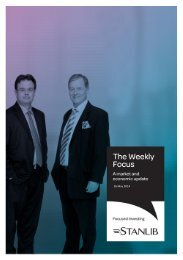nWIzLy
nWIzLy
nWIzLy
You also want an ePaper? Increase the reach of your titles
YUMPU automatically turns print PDFs into web optimized ePapers that Google loves.
08 September 2014
Contents<br />
Contents .................................................................................................................................... 2<br />
Newsflash .................................................................................................................................. 3<br />
Market Comment ........................................................................................................................................................... 3<br />
Other Commentators ...................................................................................................................................................... 4<br />
Economic Update ....................................................................................................................... 6<br />
Weekly Market Analysis ............................................................................................................. 9<br />
STANLIB Money Market Fund ....................................................................................................................................... 10<br />
STANLIB Enhanced Yield Fund ...................................................................................................................................... 10<br />
STANLIB Income Fund ................................................................................................................................................... 10<br />
STANLIB Flexible Income Fund ...................................................................................................................................... 11<br />
STANLIB Multi-Manager Absolute Income Fund .......................................................................................................... 11
Newsflash<br />
So far 2014 has been a much better year for listed property offshore and locally,<br />
especially of late<br />
Market Comment<br />
<br />
<br />
<br />
2013 was a difficult year for listed property offshore and locally, after Bernanke’s initial tapering comment in<br />
May, which sent bond yields much higher (prices down) and property shares much lower.<br />
So far 2014 has been a much better year, especially of late. In fact, quite intriguingly the JSE Listed Property Index<br />
Total Return (including dividends) at 14.92% as of last Friday is now beating the JSE All Share Index’s 14.37% (see<br />
chart below of SA Asset Class Returns).<br />
The All Bond Index has done 7.5%, also better than expected after just 8 months of the year.<br />
Source: I-Net Bridge<br />
<br />
<br />
<br />
<br />
<br />
Offshore listed property is beating equities by a much higher margin so far in 2014, with the STANLIB Global<br />
Property Feeder Fund up 14% in dollars (18.3% in rands), compared with the 7.4% total return of the MSCI World<br />
Index (including dividends).<br />
Equities did much better last year, so one could say that property is bouncing back after a difficult 2013, when<br />
global property did -3.5% in dollars and local property did 8.4% in rands.<br />
Otherwise there is no question that global bond yields especially and local bond yields are much lower than was<br />
expected at this stage of 2014, which is supportive of listed property.<br />
The graph above shows that SA Listed Property has bounced 10% in just the last 2 months. The index is a massive<br />
24.3% higher than its low at end January this year.<br />
The JSE ALSI total return index did in fact reach a record high on Thursday, but fell 242 points short of its previous<br />
record at end July excluding dividends.
This is despite the struggling JSE Mining Index, down 10.6% over the last 6 weeks, mostly because of the weak<br />
iron ore price (-38% so far in 2014), but also to an extent because of the rampant US dollar, because commodities<br />
are priced in dollars and some negative data out of China, including this morning’s imports, which were down.<br />
The Mining Index is dominated by Billiton (52% of the Index) and Anglo American (26%), with number three<br />
Anglogold way below at just 5% of the index.<br />
Fortunately Sasol has held up well so far. It is 20.7% of the Resources Index (only slightly smaller than Anglo’s<br />
20.9%), so this index is holding up better than the Mining Index.<br />
Sasol is just ten rand below its record high of 653 rand in June this year, which is interesting or surprising because<br />
the Brent oil price (now just above $100), converted into rands, is down 5.4% so far in 2014, trading where it was<br />
10 months ago. Sasol’s earnings are quite geared to the rand oil price.<br />
Meanwhile the JSE Life Insurance Index has rocketed to a new all-time record high, with a total return (including<br />
dividends) of 20.2% so far in 2014. The index comprises Old Mutual at 46% of the index, then Sanlam at 33.4%,<br />
Discovery at 8.5%, MMI Holdings at 8.1%, Liberty at 3.8% and Clientele at 0.26%.<br />
Sanlam is lately having the biggest impact on the index as its share price is up 16% in the past month and 30% so<br />
far this year. Since the low on 8 th March 2009 (exactly 5.5 years ago), Sanlam has returned 33% per year,<br />
excluding dividends, which is exceptionally good. Add in dividends and you’re looking at probably around 37-38%<br />
per year for 5.5 years compounded.<br />
Actually Discovery has done 31.5% compounded over the same period, excluding dividends, not far behind at all.<br />
So life insurance is one of the hottest sectors on the JSE!<br />
From its post-crash low of 54 rand in December 2008, Liberty has done 16.9% per year, excluding dividends.<br />
The MSCI Emerging Markets Index perked up last week to a new 3-year high, with a return of 9.4% in US Dollars<br />
so far in 2014, or 11.9% including dividends. It has continued to outperform the developed markets, by 10.5%<br />
since the relative low in March this year.<br />
MSCI China, which comprises over 18% of the MSCI Emerging Markets index, gained another 3% last week to a<br />
new 3-year high, although it remains a long way below its record high AND is still trading at levels of 19 years ago<br />
(1995)!!<br />
Other Commentators<br />
US Market Analyst, Elaine Garzarelli<br />
<br />
<br />
<br />
<br />
<br />
<br />
<br />
With the S&P 500 hitting a new high last week, investors see many positives, including lots of deals, strong<br />
economic data and earnings beating consensus estimates.<br />
Along with higher share prices, consumers are encouraged by declining petrol prices and hopefully issues in the<br />
Ukraine may be settling.<br />
Garza’s quants system remains bullish at 70.5%, where a level below 30% is bearish. The system continues to<br />
suggest the bull market is intact, so she recommends full exposure to shares in the US.<br />
The number of bullish advisors, a contrarian indicator, is back in the danger zone at 56.1% (too high, indicating<br />
that advisors have put most of their client’s cash to work in the market). Such high bullish sentiment has<br />
historically frequently led to corrections. If one were to occur, it should be no more than 4-7%.<br />
The strong dollar had put downward pressure on some commodity prices, with corn, sugar, iron ore and palm oil<br />
making new lows. The oil price is testing new lows for the year too, down 9% in dollars so far in 2014, back at<br />
June 2013’s level. This is all good for keeping US inflation down.<br />
Wages in the US are rising by just 2% too.<br />
Garza suspects that another US recession is “years away”.<br />
BCA Research<br />
<br />
Martin Barnes, Chief Economist of BCA, wrote the Global Investment Strategy this week and is in philosophical<br />
mode, discussing how the bull market is lasting so long (5.5 years old today).
He asks whether investors are in the grip of dangerous complacency or are markets responding rationally to a<br />
fundamentally bullish backdrop?<br />
He says frustratingly there is an element of truth in both views.<br />
Easy monetary policy is an obvious positive for markets, as is the hope that economic growth will improve and<br />
support expectations of better company earnings.<br />
Absent some major unexpected shock, it is not clear what will stop equities from continuing to rise for as long as<br />
the powerful combination of low rates and earnings optimism persists.<br />
He believes US equities have already reached overvalued levels, very different from Garzarelli.<br />
Europe is battling, with deleveraging still having a long way to run, while Japan’s economy is struggling after the<br />
big increase in sales tax from 5% to 8% in April.<br />
Both the US and the UK are doing better.<br />
Steve Sjuggerud’s “True Wealth”<br />
This month Steve is recommending Hong Kong Property Developers, which he thinks are trading at a 40%<br />
discount. He recommends the Guggenheim China Real Estate Fund, which trades on the New York Stock<br />
Exchange and holds Hong Kong’s leading property companies.<br />
<br />
He is also recommending Japanese small cap shares.<br />
Paul Hansen<br />
Director: Retail Investing
Economic Update<br />
United States<br />
In August 2014, the US unemployment rate improved slightly to 6.1%, from 6.2% in July 2014. This was in-line with<br />
market expectations. Unfortunately, the labour market participation rate eased further to 62.8% in August from<br />
62.9% in July. Overall, the labour market participation rate is still at its lowest level since 1978. As we have indicated<br />
previously, it seems sensible that one would argue that the labour market participation rate is probably indicating a<br />
higher level of structural unemployment in the US that is not purely related to demographics.<br />
Non-farm payrolls rose by a disappointing 142 000 jobs in August 2014. The market was expecting a gain of around<br />
230 000. The change in total nonfarm payroll employment data for the previous two months was revised down by a<br />
combined total of 28 000. Overall, the level of US employment is 753 000 above the previous peak prior to the global<br />
financial market crisis. During the financial market crisis the US lost a total of 8.7 million jobs.<br />
The private sector added 134 000 jobs in August 2014, after adding a revised 213 000 jobs in July 2014. The private<br />
sector has gained employment in each of the past 54 months at an average of 185 000 jobs a month and is at a record<br />
high, comfortably surpassing the previous peak recorded in January 2008. The number of long-term unemployed<br />
(those jobless for 27 weeks or more) declined by 192 000 to 3.0 million in August. The number of persons employed<br />
part time for economic reasons (sometimes referred to as involuntary part-time workers) was little changed in August<br />
at 7.3 million. These individuals were working part time because their hours had been cut back or because they were<br />
unable to find a full-time job.<br />
This month’s US labour market report is disappointing and in sharp contrast with the gains in employment during the<br />
preceding 6 months. Although the strike in the retail sector helps to explain some of weakness, it was certainly not<br />
sufficient to explain the broad-based lacklustre employment gains across a wide range of sectors. Overall, despite the<br />
disappointing gain in employment in August, a broad range of economic data continues to suggest that the US<br />
economy will keep growing at a respectable pace. This includes the US leading economic indicator. However, it is<br />
worthwhile noting that house prices have fallen in each of the past two months and the recovery in the US housing<br />
market remains somewhat unconvincing.<br />
US light vehicle sales rose by a massive 6.4%m/m in August 2014 to an annualised 17.45 million units. Up 9.8% yearon-year.<br />
This was above market expectations, which was for a rise to 16.6 million units. The August level of vehicle<br />
sales is the highest since well before the global financial market crisis, and up an incredible 50% since the low in June<br />
2011.<br />
US vehicles sales declined dramatically during the global financial market crisis, falling from 16 million units to 9.3<br />
million units in just 15 months. This decimated the motor trade, and ultimately led to government providing financial<br />
assistance to some of the large vehicle manufacturers. There was a boost in sales during July and August 2009 (see<br />
chart attached), although that was almost entirely due to the government’s Cash for Clunkers deal. In total 690 115<br />
new cars were purchased through the Cash for Clunkers programme, costing the government a total of $2.877 billion<br />
in support. The Cash for Clunkers deal ended on 26 August 2009.<br />
Since then the industry has experienced a remarkable improvement and has fully recovered from the previous<br />
recession, helped by both internal and external demand. Overall, the motor industry appears able to sustain the<br />
recovery, given the still low cost of finance as well as a solid improvement in employment and strong advertising by<br />
the industry, including sales promotions. In fairness, the US government should receive significant praise for assisting<br />
the motor industry during the financial crisis, thereby ultimately saving thousands of jobs.<br />
The European Central Bank announced a further package of monetary policy measures to try and avoid deflation in<br />
the region as well as further stimulate the economy. This follows a fairly extensive monetary stimulus package that<br />
was introduced in June 2014. Yesterday’s announcement reflect concerns raised by ECB President, Mario Draghi, in his<br />
recent Jackson Hole speech.
The key monetary policy measures announced yesterday by the ECB include:<br />
<br />
<br />
The interest rate on the main refinancing operations of the Euro-system will be decreased by 10 basis points to<br />
0.05%, starting from the operation to be settled on 10 September 2014 (see chart attached).<br />
The interest rate on the marginal lending facility will be decreased by 10 basis points to 0.30%, with effect from<br />
10 September 2014.<br />
The interest rate on the ECB’s deposit facility will be decreased by 10 basis points to -0.20%, with effect from 10<br />
September 2014.<br />
<br />
In June 2014 the ECB indicated that they would intensify preparatory work related to outright purchases of assetbacked<br />
securities (ABS) and yesterday the ECB decided to start purchasing non-financial private sector assets with<br />
effect from October. (The ECB decided against purchasing of government bonds, although this remains a policy<br />
option). The asset-purchase programme comprises both 'simple and transparent' ABS (underlying assets<br />
consisting of claims against euro area private non-financial sector) and covered bonds. Together with the TLTRO<br />
(first auction in mid-September), this will increase the ECB’s balance sheet, which had been declining over most of<br />
the past two years. Importantly, the size of the asset-purchase program and the details on its design will not be<br />
announced until October leaving many market participants wondering how the ECB will find sufficient ABS to<br />
implement the program, given the dearth of ABS supply in recent years.<br />
The further reduction in interest rates is unlikely to have much of an impact on the real economy, but it does add to<br />
the ECB’s stated commitment to keep interest rates extremely low for much longer. Equally, the further reduction in<br />
deposit rates is also unlikely to have much effect on the economy, partly because there is a relatively small amount of<br />
money on deposit at the ECB. However, it does add credence to the ECB’s stated policy commitment and should<br />
ultimately help consumer and business confidence.<br />
Although the ECB is clearly committed to on-going monetary stimulus, and the range of new monetary policy<br />
measures are relatively bold by European standards (especially negative deposit rates and the introduction of an<br />
asset-purchase programme) they might not be all that effective in stimulating real economic activity given the<br />
negative impact of the Russian-Ukraine crisis on Europe as well as relatively muted global growth.<br />
Kenya<br />
At their meeting on 3 September 2014 the Central Bank of Kenya decided to keep rates on hold at 8.5% as expected.<br />
The monetary policy committee felt that the current policy measures, in the form of monetary policy and liquidity<br />
management, are enough to alleviate pressures that may pose a risk to inflation expectations and that there is “no<br />
fundamental structural pressures on inflation”. However it was still concerned about inflation being above the target,<br />
and will utilise monetary policy operations to tighten policy in order to anchor inflationary expectations.<br />
The inflation rate in Kenya was recorded at 8.36% in August 2014, up from 7.67% in July, which continues the upward<br />
trend that began in April 2014. This is the highest inflation rate since June 2012, and the second month in succession<br />
where inflation has been above the 2.5% – 7.5% target band. This reflects the base effects of new taxes that were<br />
introduced in September 2013, but this is expected to start dissipating from September 2014.<br />
The central bank also mentioned in their communique that they were pleased with the progress of the recently<br />
introduced Kenya Bank’s Reference Rate (KBRR) that was implemented in July 2014 at 9.13%. So far 182 731 loans<br />
accounts worth KES 43billion have been priced using the KBRR with an average premium of 3.05% on commercial<br />
mortgages and 4.09% on corporate loans of 1 – 5 years.<br />
Kenya is the next African country that has embarked on the exercise of re-basing its GDP. The results are expected to<br />
be released by September 2014, with 2009 as the new base year. Expectations are for the country to be 20% larger<br />
than it is, upgrading Kenya to a middle income country.
Mauritius<br />
Inflation in Mauritius was recorded at 3.8% for August 2014, up from 3.1% in July, which reverses a 5 month<br />
downward trend in the inflation rate. The month on month figure registered 0.5%. Food prices were the biggest<br />
contributor to the increase in the inflation rate as vegetable prices continue to rise – in fact the increase in vegetable<br />
prices on their own contributed 0.3% percentage points to the overall inflation rate, and food as a whole constitutes<br />
29% of the bucket. The peak inflation rate of 5.6% in February 2014 and the trough in July 2014 at 3.1% were both as<br />
a result of movements in vegetable prices.<br />
The Bank of Mauritius gave forward guidance in July 2014 that it would keep rates unchanged until 2015 as long as<br />
inflation remained below 4% on a 12 month moving average basis and the growth outlook remained unchanged. The<br />
headline inflation rate for the twelve months to August 2014 is at 4.0%, which is a concern, compared to the twelve<br />
months to August 2013 where it registered 3.5%. With this in mind, rates are expected to remain unchanged at the<br />
next meeting in October with risk to the upside. The bank mentioned in the guidance that rates could increase by at<br />
least 25 basis points at its first meeting in 2015.<br />
Please follow our regular economic updates on twitter @lingskevin<br />
Kevin Lings, Laura Jones & Kganya Kgare<br />
(STANLIB Economics Team)
Weekly Market Analysis<br />
Currencies/ Indices/ Commodities<br />
Friday’s Close<br />
05/08/14<br />
Weekly Move<br />
(%)<br />
YTD<br />
(%)<br />
Indices<br />
*MSCI World – US Dollar 1750.61 0.11 5.39<br />
*MSCI World – Rand 18723.05 0.43 8.88<br />
*MSCI Emerging Market – US Dollar 1096.83 0.82 9.39<br />
*MSCI Emerging Market – Rand 11730.76 1.15 13.01<br />
All Share Index – US Dollar 4844.07 1.31 8.39<br />
All Share Index – Rand 51789.40 1.63 11.96<br />
All Bond Index 469.41 0.14 7.50<br />
Listed Property J253 1603.67 2.99 14.92<br />
Currencies<br />
US Dollar/Rand 10.69 0.32 3.30<br />
Euro/Rand 13.67 -0.77 -5.20<br />
Sterling/Rand 17.45 -1.36 0.58<br />
Euro/US Dollar 1.30 -1.38 -5.76<br />
Commodities<br />
Oil Brent Crude Spot Price ($/bl) 100.79 -2.08 -9.03<br />
Gold Price $/oz 1268.71 -1.46 5.24<br />
Platinum Price S/oz 1411.00 -0.95 2.84<br />
Source: I-Net Bridge<br />
* MSCI - Morgan Stanley Capital International
Rates<br />
These rates are expressed in nominal and effective terms and should be used for indication purposes ONLY.<br />
STANLIB Money Market Fund<br />
Nominal:<br />
Effective:<br />
5.97% per annum<br />
6.13% per annum<br />
STANLIB is required to quote an effective rate which is based upon a seven-day rolling average yield for Money<br />
Market Portfolios. The above quoted yield is calculated using an annualised seven-day rolling average as at 06<br />
September 2014. This seven- day rolling average yield may marginally differ from the actual daily distribution and<br />
should not be used for interest calculation purposes. We however, are most happy to supply you with the daily<br />
distribution rate on request, one day in arrears. The price of each participatory interest (unit) is aimed at a constant<br />
value. The total return to the investor is primarily made up of interest received but, may also include any gain or loss<br />
made on any particular instrument. In most cases this will merely have the effect of increasing or decreasing the daily<br />
yield, but in an extreme case it can have the effect of reducing the capital value of the portfolio.<br />
STANLIB Enhanced Yield Fund<br />
Effective Yield: 6.06%<br />
STANLIB is required to quote a current yield for Income Portfolios. This is an effective yield. The above quoted yield<br />
will vary from day to day and is a current yield as at 05 September 2014. The net (after fees) yield on the portfolio will<br />
be published daily in the major newspapers together with the “all-in” NAV price (includes the accrual for dividends<br />
and interest). This yield is a snapshot yield that reflects the weighted average running yield of all the underlying<br />
holdings of the portfolio. Monthly distributions will consist of dividends and interest. Interest will also be exempt from<br />
tax to the extent that investor’s are able to make use of the applicable interest exemption as currently allowed by the<br />
Income Tax Act. The portfolio’s underlying investments will determine the split between dividends and interest.<br />
STANLIB Income Fund<br />
Effective Yield: 7.03%<br />
Collective Investment Schemes in Securities (CIS) are generally medium to long term investments. The value of<br />
participatory interests may go down as well as up and past performance is not necessarily a guide to the future. A<br />
schedule of fees and charges and maximum commissions is available on request from the company/scheme. CIS can<br />
engage in borrowing and scrip lending. Commission and incentives may be paid and if so, would be included in the<br />
overall costs.” The above quoted yield will vary from day to day and is a current yield as at 05 September 2014.
STANLIB Extra Income Fund<br />
Effective Yield: 6.59%<br />
Collective Investment Schemes in Securities (CIS) are generally medium to long term investments. The value of<br />
participatory interests may go down as well as up and past performance is not necessarily a guide to the future. A<br />
schedule of fees and charges and maximum commissions is available on request from the company/scheme. CIS can<br />
engage in borrowing and scrip lending. Commission and incentives may be paid and if so, would be included in the<br />
overall costs.<br />
Fluctuations or movements in exchange rates may cause the value of underlying international investments to go up or<br />
down.” The above quoted yield will vary from day to day and is a current yield as at 05 September 2014.<br />
STANLIB Flexible Income Fund<br />
Effective Yield: 6.87%<br />
Collective Investment Schemes in Securities (CIS) are generally medium to long term investments. The value of<br />
participatory interests may go down as well as up and past performance is not necessarily a guide to the future. A<br />
schedule of fees and charges and maximum commissions is available on request from the company/scheme. CIS can<br />
engage in borrowing and scrip lending. Commission and incentives may be paid and if so, would be included in the<br />
overall costs.” The above quoted yield will vary from day to day and is a current yield as at 05 September 2014.<br />
STANLIB Multi-Manager Absolute Income Fund<br />
Effective Yield: 6.31%<br />
Collective Investment Schemes in Securities (CIS) are generally medium to long term investments. The value of<br />
participatory interests may go down as well as up and past performance is not necessarily a guide to the future. A<br />
schedule of fees and charges and maximum commissions is available on request from the company/scheme. CIS can<br />
engage in borrowing and scrip lending. Commission and incentives may be paid and if so, would be included in the<br />
overall costs.” The above quoted yield will vary from day to day and is a current yield as at 05 September 2014.
Glossary of terminology<br />
Bonds<br />
A bond is an interest-bearing debt instrument, traditionally issued by governments as part of<br />
their budget funding sources, and now also issued by local authorities (municipalities),<br />
parastatals (Eskom) and companies. Bonds issued by the central government are often<br />
called “gilts”. Bond issuers pay interest (called the “coupon”) to the bondholder every 6<br />
months. The price/value of a bond has an inverse relationship to the prevailing interest rate,<br />
so if the interest rate goes up, the value goes down, and vice versa. Bonds/gilts generally<br />
have a lower risk than shares because the holder of a gilt has the security of knowing that<br />
the gilt will be repaid in full by government or semi-government authorities at a specific<br />
time in the future. An investment in this type of asset should be viewed with a 3 to 6 year<br />
horizon.<br />
Cash<br />
Collective<br />
Investments<br />
Compound Interest<br />
Dividend Yields<br />
Dividends<br />
Earnings per share<br />
An investment in cash usually refers to a savings or fixed-deposit account with a bank, or to<br />
a money market investment. Cash is generally regarded as the safest investment. Whilst it is<br />
theoretically possible to make a capital loss investing in cash, it is highly unlikely. An<br />
investment in this type of asset should be viewed with a 1 to 3 year horizon.<br />
Collective investments are investments in which investors‟ funds are pooled and managed<br />
by professional managers. Investing in shares has traditionally yielded unrivalled returns,<br />
offering investors the opportunity to build real wealth. Yet, the large amounts of money<br />
required to purchase these shares is often out of reach of smaller investors. The pooling of<br />
investors’ funds makes collective investments the ideal option, providing cost effective<br />
access to the world’s stock markets. This is why investing in collective investments has<br />
become so popular the world over and is considered a sound financial move by most<br />
investors.<br />
Compound interest refers to the interest earned on interest that was earned earlier and<br />
credited to the capital amount. For example, if you deposit R1 000 in a bank account at 10%<br />
and interest is calculated annually; your balance will be R1 100 at the end of the first year<br />
and R1 210 at the end of the second year. That extra R10, which was earned on the interest<br />
from the first year, is the result of compound interest ("interest on interest"). Interest can<br />
also be compounded on a monthly, quarterly, half-yearly or other basis.<br />
The dividend yield is a financial ratio that shows how much a company pays out in dividends<br />
each year relative to its share price. The higher the yield, the more money you will get back<br />
on your investment.<br />
When you buy equities offered by a company, you are effectively buying a portion of the<br />
company. Dividends are an investor’s share of a company’s profits, given to him or her as a<br />
part-owner of the company.<br />
Earnings per share is a measure of how much money the company has available for<br />
distribution to shareholders. A company’s earnings per share is a good indication of its<br />
profitability and is generally considered to be the most important variable in determining a<br />
company’s share price.
Equity<br />
Financial Markets<br />
Fixed Interest Funds<br />
Gross Domestic<br />
Product (GDP)<br />
Growth Funds<br />
Industrial Funds<br />
Investment Portfolio<br />
JSE Securities<br />
Exchange<br />
Price to earnings<br />
ratio<br />
Property<br />
Resources and Basic<br />
Industries Funds<br />
A share represents an institution/individual’s ownership in a listed company and is the<br />
vehicle through which they are able to “share” in the profits made by that company. As the<br />
company grows, and the expectation of improved profits increases, the market price of the<br />
share will increase and this translates into a capital gain for the shareholder. Similarly,<br />
negative sentiment about the company will result in the share price falling. Shares/equities<br />
are usually considered to have the potential for the highest return of all the investment<br />
classes, but with a higher level of risk i.e. share investments have the most volatile returns<br />
over the short term. An investment in this type of asset should be viewed with a 7 to 10 year<br />
horizon.<br />
Financial markets are the institutional arrangements and conventions that exist for the issue<br />
and trading of financial instruments.<br />
Fixed interest funds invest in bonds, fixed-interest and money market instruments. Interest<br />
income is a feature of these funds and, in general, capital should remain stable.<br />
The Gross Domestic Product measures the total volume of goods and services produced in<br />
the economy. Therefore, the percentage change in the GDP from year to year reflects the<br />
country's annual economic growth rate.<br />
Growth funds seek maximum capital appreciation by investing in rapidly growing companies<br />
across all sectors of the JSE. Growth companies are those whose profits are in a strong<br />
upward trend, or are expected to grow strongly, and which normally trade at a higher-thanaverage<br />
price/earnings ratio.<br />
Industrial funds invest in selected industrial companies listed on the JSE, but excluding all<br />
companies listed in the resources and financial economic groups.<br />
An investment portfolio is a collection of securities owned by an individual or institution<br />
(such as a collective investment scheme). A funds‛ portfolio may include a combination of<br />
financial instruments such as bonds, equities, money market securities, etc. The theory is<br />
that the investments should be spread over a range of options in order to diversify and<br />
spread risk.<br />
The primary role of the JSE Securities Exchange is to provide a market where securities can<br />
be freely traded under regulated procedures.<br />
Price to earnings ratio or p: e ratio is calculated by dividing the price per share by the<br />
earnings per share. This ratio provides a better indication of the value of a share, than the<br />
market price alone. For example, all things being equal, a R10 share with a P/E of 75 is much<br />
more “expensive” than a R100 share with a P/E of 20.<br />
Property has some attributes of shares and some attributes of bonds. Property yields are<br />
normally stable and predictable because they comprise many contractual leases. These<br />
leases generate rental income that is passed through to investors. Property share prices<br />
however fluctuate with supply and demand and are counter cyclical to the interest rate<br />
cycle. Property is an excellent inflation hedge as rentals escalate with inflation, ensuring<br />
distribution growth, and property values escalate with inflation ensuring net asset value<br />
growth. This ensures real returns over the long term.<br />
These funds seek capital appreciation by investing in the shares of companies whose main<br />
business operations involve the exploration, mining, distribution and processing of metals,<br />
minerals, energy, chemicals, forestry and other natural resources, or where at least 50<br />
percent of their earnings are derived from such business activities, and excludes service<br />
providers to these companies.
Smaller Companies<br />
Funds<br />
Value Funds<br />
Growth Funds<br />
Smaller Companies Funds seek maximum capital appreciation by investing in both<br />
established smaller companies and emerging companies. At least 75 percent of the fund<br />
must be invested in small- to mid-cap shares which fall outside of the top 40 JSE-listed<br />
companies by market capitalisation.<br />
These funds aim to deliver medium- to long-term capital appreciation by investing in value<br />
shares with low price/earnings ratios and shares which trade at a discount to their net asset<br />
value.<br />
Growth funds seek maximum capital appreciation by investing in rapidly growing companies<br />
across all sectors of the JSE. Growth companies are those whose profits are in a strong<br />
upward trend, or are expected to grow strongly, and which normally trade at a higher-thanaverage<br />
price/earnings ratio.<br />
Sources: Unit Trust and Collective Investments (September 2007), The Financial Sector Charter Council, Personal Finance (30 November 2002),<br />
Introduction to Financial Markets, Personal Finance, Quarter 4 2007, Investopedia (www.investopedia.com) and The South African Financial<br />
Planning Handbook 2004.
Disclaimer<br />
The price of each unit of a domestic money market portfolio is aimed at a constant value. The total return to the investor is primarily made up of<br />
interest received but, may also include any gain or loss made on any particular instrument. In most cases this will merely have the effect of<br />
increasing or decreasing the daily yield, but in an extreme case it can have the effect of reducing the capital value of the portfolio. Collective<br />
Investment Schemes in Securities (CIS) are generally medium to long term investments. The value of participatory interests may go down as well as<br />
up and past performance is not necessarily a guide to the future. An investment in the participations of a CIS in securities is not the same as a<br />
deposit with a banking institution. CIS are traded at ruling prices and can engage in borrowing and scrip lending. A schedule of fees and charges and<br />
maximum commissions is available on request from STANLIB Collective Investments Ltd (the Manager). Commission and incentives may be paid and<br />
if so, would be included in the overall costs. A fund of funds is a portfolio that invests in portfolios of collective investment schemes, which levy<br />
their own charges, which could result in a higher fee structure for these portfolios. Forward pricing is used. Fluctuations or movements in exchange<br />
rates may cause the value of underlying international investments to go up or down. TER is the annualised percent of the average Net Asset Value<br />
of the portfolio incurred as charges, levies and fees. A higher TER ratio does not necessarily imply a poor return, nor does a low TER imply a good<br />
return. The current TER cannot be regarded as an indication of future TERs. Portfolios are valued on a daily basis at 15h30. Investments and<br />
repurchases will receive the price of the same day if received prior to 15h30. Liberty is a full member of the Association for Savings and Investments<br />
of South Africa. The Manager is a member of the Liberty Group of Companies.<br />
As neither STANLIB Wealth Management Limited nor its representatives did a full needs analysis in respect of a particular investor, the investor<br />
understands that there may be limitations on the appropriateness of any information in this document with regard to the investor’s unique<br />
objectives, financial situation and particular needs. The information and content of this document are intended to be for information purposes only<br />
and STANLIB does not guarantee the suitability or potential value of any information contained herein. STANLIB Wealth Management Limited does<br />
not expressly or by implication propose that the products or services offered in this document are appropriate to the particular investment<br />
objectives or needs of any existing or prospective client. Potential investors are advised to seek independent advice from an authorized financial<br />
adviser in this regard. STANLIB Wealth Management Limited is an authorised Financial Services Provider in terms of the Financial Advisory and<br />
Intermediary Services Act 37 of 2002 (Licence No. 26/10/590)<br />
Compliance No.: H23X61<br />
17 Melrose Boulevard, Melrose Arch, 2196<br />
P O Box 202, Melrose Arch, 2076<br />
T 0860123 003 (SA Only)<br />
T+27(0)11 448 6000<br />
E contact@stanlib.com<br />
Website www.stanlib.com<br />
STANLIB Wealth Management Limited<br />
Reg. No. 1996/005412/06<br />
Authorised FSP in terms of the FAIS Act, 2002 (Licence<br />
No. 26/10/590)<br />
STANLIB Collective Investments Limited<br />
Reg. No. 1969/003468/06


